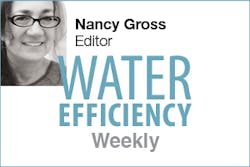We ran an article in our September/October issue of Water Efficiency on water-quality trading (WQT), which, in a nutshell, often hinges on pollution reduction and ecosystem restoration through planting of native plants along the riverbanks. One paragraph from the section about Clean Water Services, the regional public utility in Oregon that protects the Tualatin River, sprung to my mind when I came across a news items on beaver ponds in the northeastern United States. Our article quotes Bruce Roll, Clean Water Services’ director of watershed management.
Beavers returned in the fifth year of the WQT program in numbers not seen in decades, according to Roll, who says although they are controversial, they perform valuable functions. Beavers build ponds covering one or two acres, stabilizing the water flow and cooling the water temperature. They also build up woody, organic material that young trout and salmon fish use to hide in to keep safe from predators during their first year. Beavers also prevent erosion. “They are some of the best stormwater tools you’ll ever have,” says Roll.
The article I came across on Science Daily, “Beavers take a chunk out of nitrogen in Northeast rivers” discusses a study by Arthur Gold of the University of Rhode Island on how the presence of beavers affects nitrogen levels in Northeast waters.
Nitrogen levels have been increasing in Northeast waters for years. The use of nitrogen fertilizers has risen and urbanization has brought in influences such as septic systems. This nitrogen is released into small streams and ponds and eventually travels to estuaries, where rivers meet the sea.
High levels of nitrogen in these areas stimulate algal blooms. As these organisms die and decompose, oxygen is consumed from bottom waters, creating low oxygen levels that can generate fish kills. While many know of these dead zones in the Gulf of Mexico, they are also becoming a problem for the plentiful estuaries that comprise the coastline of the Northeast U.S.
“What motivated us initially to study this process was that we were aware of the fact that beaver ponds were increasing across the Northeast,” he said. “We observed in our other studies on nitrogen movement that when a beaver pond was upstream, it would confound our results.”
The researchers set about trying to replicate, in soil, the conditions of retention time and organic matter buildup found in the ponds, to see if denitrification would occur. Their results approximated the results they were finding from the beaver ponds.
The research has some interesting implications. Julia Lazar, who conducted the work as part of her doctoral dissertation and is now working as an environmental consultant, said it might change the way people think about beavers and their ponds.
“Most of these beavers are in areas with smaller streams, not big rivers,” Lazar said. “These smaller streams are usually the first to be developed, causing a decrease in beaver populations. So, it may be important to keep these areas from being developed so they can have effects on nitrogen levels downstream.”
Gold hopes to study the ponds over a longer period and to study abandoned ponds to see if the nitrogen retaining qualities remain after the beavers are gone.
“It’s noteworthy that the beavers have such an impact on improving nitrogen downstream,” Gold said. “We have a species whose population crashed from wide-spread trapping 150 years ago. With their return they help solve one of the major problems of the 21st century. I don’t want to minimize that. We have to remember that those ponds wouldn’t be there without the beavers.”
I am impressed. Maybe even smitten. And equally so watching the video below that shows how beavers build dams. (If you were to cross me, when I’m doing housework, with my mild-mannered, fluffy, instinct-driven but typically leisure-loving cat, I think the result would be a beaver).
The creators of the nonprofit Beavers: Wetlands and Wildlife, or BWW, have also noted the way beaver activity cleans water of human-caused pollutants. Their website’s “About Beavers” tab begins:
Lastly, since we cannot count on Beavers for all our environmental design needs, I want to direct readers to Forester University’s upcoming “Sediment & Erosion Control for Roadway Projects Master Class Series,” November 11 – December 18. “Join industry expert and best-selling author Jerald S. Fifield, Ph.D., CISEC, CPESC and Tina R. Wills, PE, CISEC, CPESC for an advanced, comprehensive 6-part live and on-demand master class and workshop series (9 PDHs / 0.9 CEUs) exploring the ins and outs of effective sediment and erosion control plan design and review for roadway projects.” For more information, including how to register, click on the link above.Beavers are more than intriguing animals with flat tails and lustrous fur. American Indians called the beaver the “sacred center” of the land because this species creates such rich, watery habitat for other mammals, fish, turtles, frogs, birds and ducks. We now know that beaver damming provides essential natural services for people too.
Beavers prefer to dam streams in shallow valleys, where the flooded area becomes productive wetlands. These cradles of life support biodiversity that rivals tropical rain forests. Almost half of endangered and threatened species in North America rely upon wetlands. Freshwater wetlands have been rated as the world’s most valuable land-based ecosystem.
Beavers reliably and economically maintain wetlands that sponge up floodwaters, alleviate droughts and floods (because their dams keep water on the land longer), lesson erosion, raise the water table and act as the “earth’s kidneys” to purify water. The latter occurs because several feet of silt collect upstream of older beaver dams, and toxics, such as pesticides, are broken down by microbes in the wetlands that beavers create. Thus, water downstream of dams is cleaner and requires less treatment for human use.

